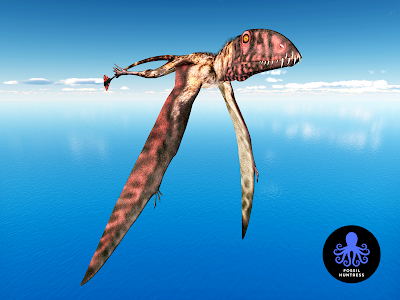This remarkable fellow is Dimorphodon — a genus of medium-sized pterosaur from the Early Jurassic. He is another favourite of mine for his charming awkwardness.
Mary's specimen was acquired by William Buckland and reported in a meeting of the Geological Society on 5 February 1829. Six years later, in 1835, William Clift and William John Broderip built upon the work by Buckland to publish in the Transactions of the Geological Society, describing and naming the fossil as a new species.
As was the case with most early pterosaur finds, Buckland classified the remains in the genus Pterodactylus, coining the new species Pterodactylus macronyx. The specific name is derived from Greek makros, "large" and onyx, "claw", in reference to the large claws of the hand. The specimen, presently NHMUK PV R 1034, consisted of a partial and disarticulated skeleton on a slab — notably lacking the skull. Buckland in 1835 also assigned a piece of the jaw from the collection of Elizabeth Philpot to P. macronyx.
Later, the many putative species assigned to Pterodactylus had become so anatomically diverse that they began to be broken into separate genera.
In 1858, Richard Owen reported finding two new specimens, NHMUK PV OR 41212 and NHMUK PV R 1035, again partial skeletons but this time including the skulls. Having found the skull to be very different from that of Pterodactylus, Owen assigned Pterodactylus macronyx its own genus, which he named Dimorphodon.
His first report contained no description and the name remained a nomen nudum. In 1859, however, a subsequent publication by Owen provided a description. After several studies highlighting aspects of Dimorphodon's anatomy, Owen finally made NHMUK PV R 1034 the holotype in 1874 — 185 million years after cruising our skies the Dimorphodon had finally fully arrived.

